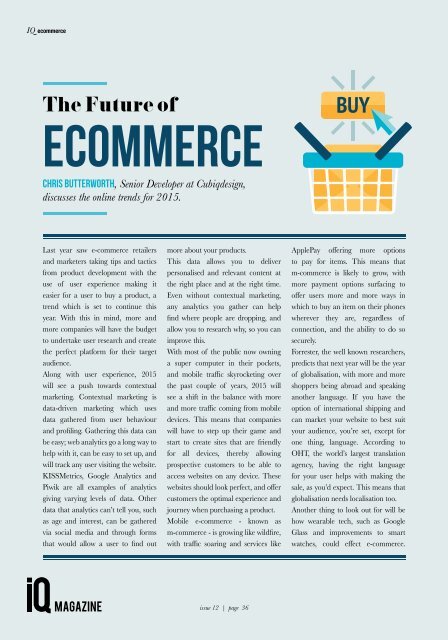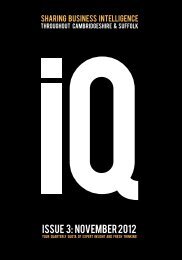IQ-Magazine-Issue-12
Create successful ePaper yourself
Turn your PDF publications into a flip-book with our unique Google optimized e-Paper software.
<strong>IQ</strong> ecommerce<br />
The Future of<br />
Ecommerce<br />
Chris Butterworth, Senior Developer at Cubiqdesign,<br />
discusses the online trends for 2015.<br />
Last year saw e-commerce retailers<br />
and marketers taking tips and tactics<br />
from product development with the<br />
use of user experience making it<br />
easier for a user to buy a product, a<br />
trend which is set to continue this<br />
year. With this in mind, more and<br />
more companies will have the budget<br />
to undertake user research and create<br />
the perfect platform for their target<br />
audience.<br />
Along with user experience, 2015<br />
will see a push towards contextual<br />
marketing. Contextual marketing is<br />
data-driven marketing which uses<br />
data gathered from user behaviour<br />
and profiling. Gathering this data can<br />
be easy; web analytics go a long way to<br />
help with it, can be easy to set up, and<br />
will track any user visiting the website.<br />
KISSMetrics, Google Analytics and<br />
Piwik are all examples of analytics<br />
giving varying levels of data. Other<br />
data that analytics can’t tell you, such<br />
as age and interest, can be gathered<br />
via social media and through forms<br />
that would allow a user to find out<br />
more about your products.<br />
This data allows you to deliver<br />
personalised and relevant content at<br />
the right place and at the right time.<br />
Even without contextual marketing,<br />
any analytics you gather can help<br />
find where people are dropping, and<br />
allow you to research why, so you can<br />
improve this.<br />
With most of the public now owning<br />
a super computer in their pockets,<br />
and mobile traffic skyrocketing over<br />
the past couple of years, 2015 will<br />
see a shift in the balance with more<br />
and more traffic coming from mobile<br />
devices. This means that companies<br />
will have to step up their game and<br />
start to create sites that are friendly<br />
for all devices, thereby allowing<br />
prospective customers to be able to<br />
access websites on any device. These<br />
websites should look perfect, and offer<br />
customers the optimal experience and<br />
journey when purchasing a product.<br />
Mobile e-commerce - known as<br />
m-commerce - is growing like wildfire,<br />
with traffic soaring and services like<br />
ApplePay offering more options<br />
to pay for items. This means that<br />
m-commerce is likely to grow, with<br />
more payment options surfacing to<br />
offer users more and more ways in<br />
which to buy an item on their phones<br />
wherever they are, regardless of<br />
connection, and the ability to do so<br />
securely.<br />
Forrester, the well known researchers,<br />
predicts that next year will be the year<br />
of globalisation, with more and more<br />
shoppers being abroad and speaking<br />
another language. If you have the<br />
option of international shipping and<br />
can market your website to best suit<br />
your audience, you’re set, except for<br />
one thing, language. According to<br />
OHT, the world’s largest translation<br />
agency, having the right language<br />
for your user helps with making the<br />
sale, as you’d expect. This means that<br />
globalisation needs localisation too.<br />
Another thing to look out for will be<br />
how wearable tech, such as Google<br />
Glass and improvements to smart<br />
watches, could effect e-commerce.<br />
issue <strong>12</strong> | page 36

















